+Search query
-Structure paper
| Title | Structural insights into light-gating of potassium-selective channelrhodopsin. |
|---|---|
| Journal, issue, pages | Nat Commun, Vol. 16, Issue 1, Page 1283, Year 2025 |
| Publish date | Feb 3, 2025 |
 Authors Authors | Takefumi Morizumi / Kyumhyuk Kim / Hai Li / Probal Nag / Tal Dogon / Oleg A Sineshchekov / Yumei Wang / Leonid S Brown / Songhwan Hwang / Han Sun / Ana-Nicoleta Bondar / Igor Schapiro / Elena G Govorunova / John L Spudich / Oliver P Ernst /      |
| PubMed Abstract | Structural information on channelrhodopsins' mechanism of light-gated ion conductance is scarce, limiting its engineering as optogenetic tools. Here, we use single-particle cryo-electron microscopy ...Structural information on channelrhodopsins' mechanism of light-gated ion conductance is scarce, limiting its engineering as optogenetic tools. Here, we use single-particle cryo-electron microscopy of peptidisc-incorporated protein samples to determine the structures of the slow-cycling mutant C110A of kalium channelrhodopsin 1 from Hyphochytrium catenoides (HcKCR1) in the dark and upon laser flash excitation. Upon photoisomerization of the retinal chromophore, the retinylidene Schiff base NH-bond reorients from the extracellular to the cytoplasmic side. This switch triggers a series of side chain reorientations and merges intramolecular cavities into a transmembrane K conduction pathway. Molecular dynamics simulations confirm K flux through the illuminated state but not through the resting state. The overall displacement between the closed and the open structure is small, involving mainly side chain rearrangements. Asp105 and Asp116 play a key role in K conductance. Structure-guided mutagenesis and patch-clamp analysis reveal the roles of the pathway-forming residues in channel gating and selectivity. |
 External links External links |  Nat Commun / Nat Commun /  PubMed:39900567 / PubMed:39900567 /  PubMed Central PubMed Central |
| Methods | EM (single particle) |
| Resolution | 3.05 - 3.44 Å |
| Structure data | EMDB-45467, PDB-9cdc: EMDB-45468, PDB-9cdd: EMDB-45469, PDB-9cde: |
| Chemicals |  ChemComp-RET: 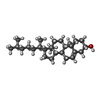 ChemComp-CLR:  ChemComp-PEE:  ChemComp-HOH: |
| Source |
|
 Keywords Keywords | MEMBRANE PROTEIN / Retinal Protein / Channelrhodopsin / Cation Channel / Peptidisc / Optogenetics / Transport Protein |
 Movie
Movie Controller
Controller Structure viewers
Structure viewers About Yorodumi Papers
About Yorodumi Papers



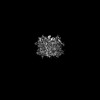
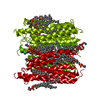
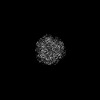


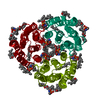
 hyphochytrium catenoides (eukaryote)
hyphochytrium catenoides (eukaryote)